Blog

For your research work for your bachelor’s, master’s or doctoral studies, for your term papers, papers and presentations you can currently access more than 3.9 million images in the image archive. However, images that you need for your specific research are often missing. With a personal account you can upload these images to your own image database and assign them to your image collections.
You can also specify whether you want to make the uploaded image(s) available to everyone in prometheus after editorial review in the interests of quality assurance by the prometheus office…

…or if you don’t want to publish: simply remove the preset check mark.
If the material for your research involves entire image pools, we can also set up your own research database like those that already exist for various institutions and projects. Please send us an email with a brief description of your research topic. We would be happy to advise you.
If you have general questions about your research data management you can also contact the helpdesk at NFDI4Culture. A team is available there to provide advice. Depending on the focus of the topic, complexity and subject area, additional experts from the consortium are included in the consulting process.
Have you already noticed the change in the left navigation bar on the “prometheus – the distributed digital image archive for research and teaching” website?
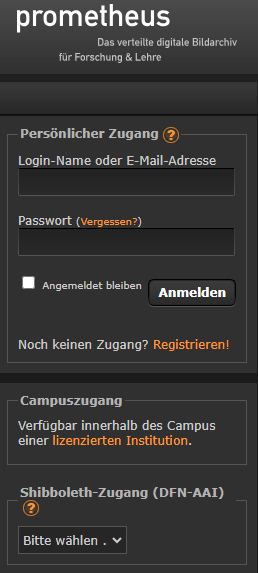
There are now three different ways to access the image archive. Campus access is not new. If you are located with your PC within a network of the currently 166 licensed institutions, you can use the campus access. Once you have read and confirmed the terms of use, you can use the simple and advanced search functions.
Personal access is also not new. If you don’t have one yet, you can register to use the image archive, free of charge if you belong to one of the licensed institutions already mentioned. With a personal account, you can create additional image collections, easily create your own image database or save your preferred settings. For a one-week trial access, fill out a short form and after verification of your research interest you will be activated.
A new option is “Shibboleth access (DFN)”. As announced in September last year you can log in there via “Single-Sign-On” if you belong to one of the following institutions: Pädagogisches Zentrum Basel-Stadt, Bibliothek Universität Greifswald, Universität zu Köln, Zürcher Hochschule der Künste. Further institutions will follow.
At the beginning of this year, we also took a look at which artists you searched for most frequently last year. Here are the top 20:
1. Andy Warhol
2. Caspar David Friedrich
3. Pablo Picasso
4. Salvador Dali
5. Giotto
6. René Magritte
7. Max Ernst
8. Hannah Höch
9. Caravaggio
10. Gerhard Richter
11. Artemisia Gentileschi
12. Otto Dix
13. Hilma af Klint
14. Frida Kahlo
15. Gabriele Münter
16. Wassily Kandinsky
17. Albrecht Dürer
18. Vincent van Gogh
19. Roy Lichtenstein
20. Cindy Sherman.
If we compare this ranking with last year’s, there have been some shifts. Last year’s number 1 “Pablo Picasso” has slipped down two places and number 2 “Vincent van Gogh” to 18th place. Andy Warhol”, who was not even in the top 20 last year, has climbed to the very top and ‘Caspar David Friedrich’ has also made a leap from 8 to 2. “Hannah Höch” was the most searched-for artist both last year and this year:
1. Pablo Picasso
2. Vincent van Gogh
3. Max Ernst
4. Hannah Höch
5. René Magritte
6. Claude Monet
7. Gabriele Münter
8. Caspar David Friedrich
9. Paula Modersohn-Becker
10. Hilma af Klint
11. Caravaggio
12. Albrecht Dürer
13. Otto Dix
14. Frida Kahlo
15. Nan Goldin
16. Henri Matisse
17. Gerhard Richter
18. Kandinsky
19. Rebecca Horn
20. Cindy Sherman.
The Art Compass(Kunstkompass) has provided a different kind of ranking every year since 1970. The journalist Linde Rohr-Bongard compiles this list of the world’s most sought-after contemporary artists, evaluating and weighting them with points.
The top 10 most important artists globally according to The Art Compass:
1. Gerhard Richter
2. Bruce Nauman
3. Georg Baselitz
4. Rosemarie Trockel
5. Tony Cragg
6. Cindy Sherman
7. Ólafur Elíasson
8. Anselm Kiefer
9. William Kentridge
10. Imi Knoebel.
Interesting, but not surprising, that there are so few points of intersection here, isn’t it?
With 59,734 data sets, the next image database in prometheus is integrated thanks to a public API. The Art Institute of Chicago offers free and unrestricted use of images of works from its collection that are presumably in the public domain or for which the museum has otherwise waived all copyrights. On its website, the museum describes what this use can look like using the example of cat images for social media platforms.

With this new image database, we are just short of the 4 million images in prometheus. A milestone that we will reach next year. :-)
You can display your search results in prometheus sorted according to different criteria. In our example, we searched for “Christmas” in the title in the advanced search, did not restrict the selection of image databases and then received 469 records in the results list. The default setting was sorting by relevance in the gallery view.
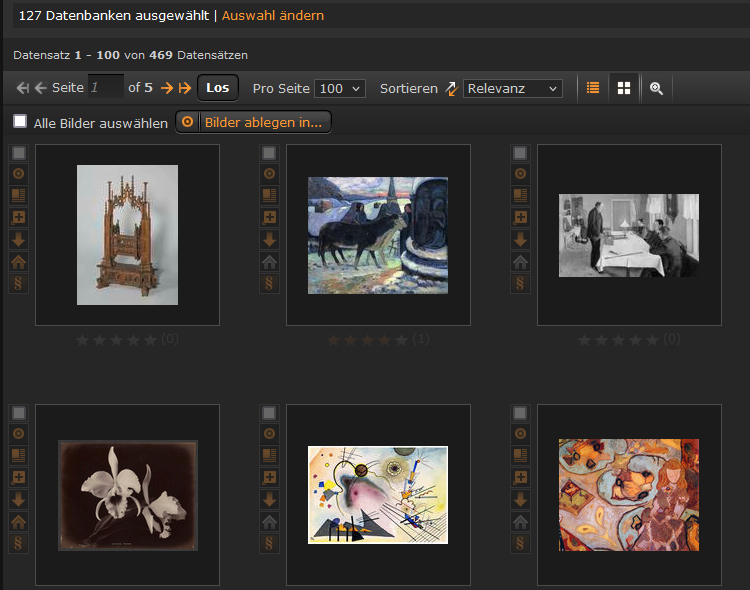
Try sorting by artist or title. It’s not just the order of the images displayed that changes. The information “artist” or “title” is also displayed under the thumbnails in the gallery view. Just like when sorting by date:
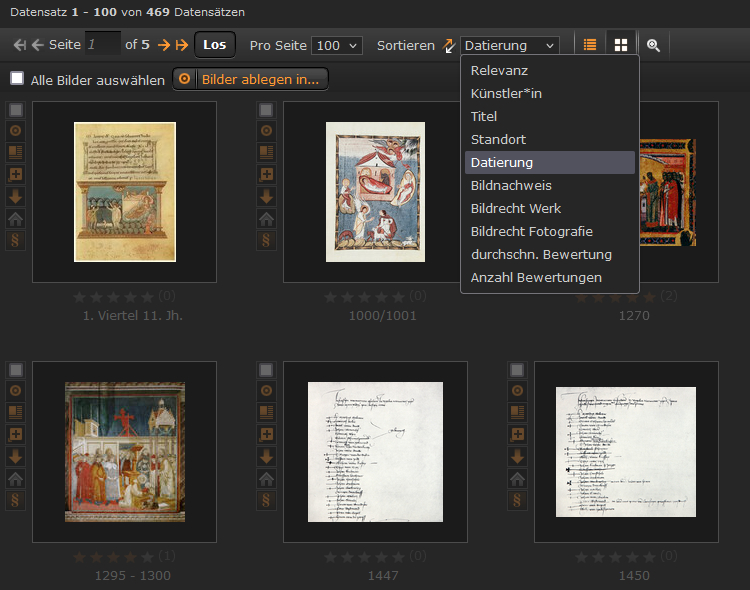
We have a digital Advent calendar again this year: #promvent24. This time, images and information about #zahlenausdembildarchiv (numbers from the image archive) can be found behind the windows of the #zahlenausallerwelt on the social media platforms Facebook, Instagram, Mastodon and LinkedIn.
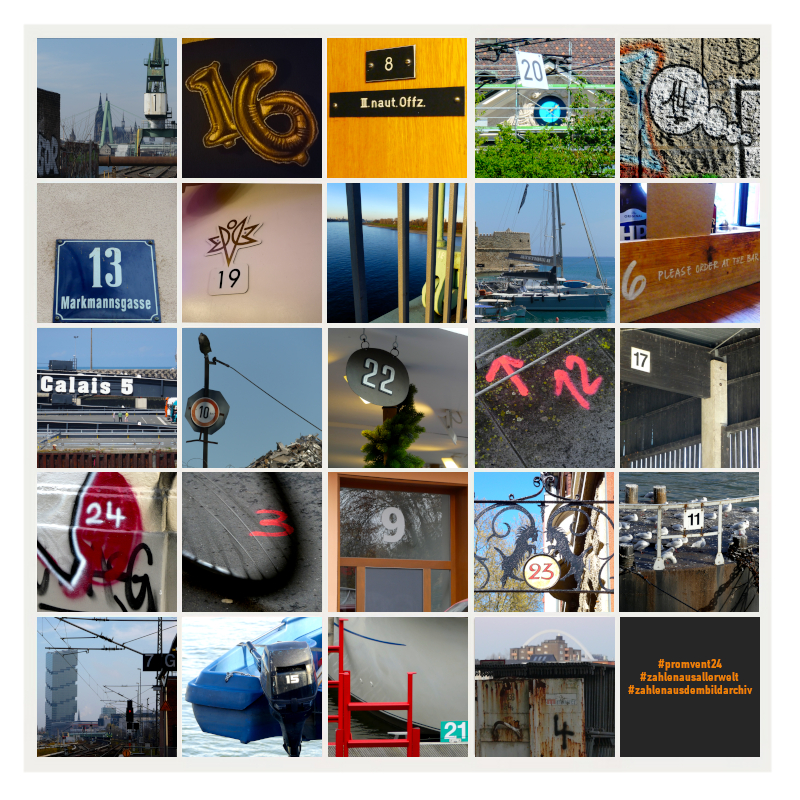

Already during the project lifecycle of prometheus, two years after its launch, the association “prometheus – The distributed digital image archive for research and teaching e.V.” was founded in 2003 to consolidate what had been achieved in the project. In 2004, it then took over the legal succession of the project in order to ensure the financing and technical structure of prometheus and to further develop the image archive, including the learning elements. If you would like to participate in the association and actively contribute to promoting science and research through the development, provision and application of digital media in the field of art and cultural history, you are cordially invited to become a member.
There are currently 50,057 image collections in prometheus and 1,723 of these are public image collections, readable or writable. These image collections can be created and viewed by anyone with personal access. You can use them privately to collect images, share them with individuals or everyone else to pool your search results. You can also download them for further use in a research or teaching context.
(1) as a zip file for unpacking: in a folder you will then have the images and text files with the corresponding metadata for each individual image.

(2) as a PowerPoint file: a slide is created for each image including the metadata title, artist, date and location.

In addition, you can enrich your own and public image collections to create material collections. On the one hand, by adding a description of the topic of the image collection or keywords that can be clicked to search for other image collections on the topic. On the other hand, you can fill it up by adding literature references and web addresses, externally for content on the topic or internally for relevant image collections in the image archive. You can mention further information, suggestions for discussion and research questions in the comments.
The beginning of the semester seems like a good time to inform you about possible adjustments to your profile and settings. If you do not yet have a personal account with prometheus or no longer have one, you can register or extend your account and if you (then) have a personal account and are logged in, you can create and customize your profile.
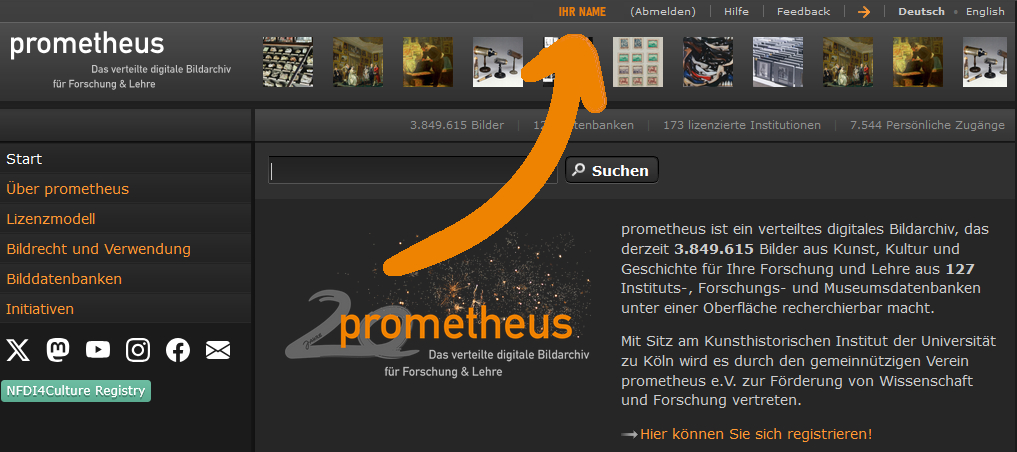
Click on the name then on the pen and you can enter a new e-mail address or a new name, change your password or specify your research interests.
You can also change your institution or your license there by clicking on “Purchase a new license or change your institution …”.
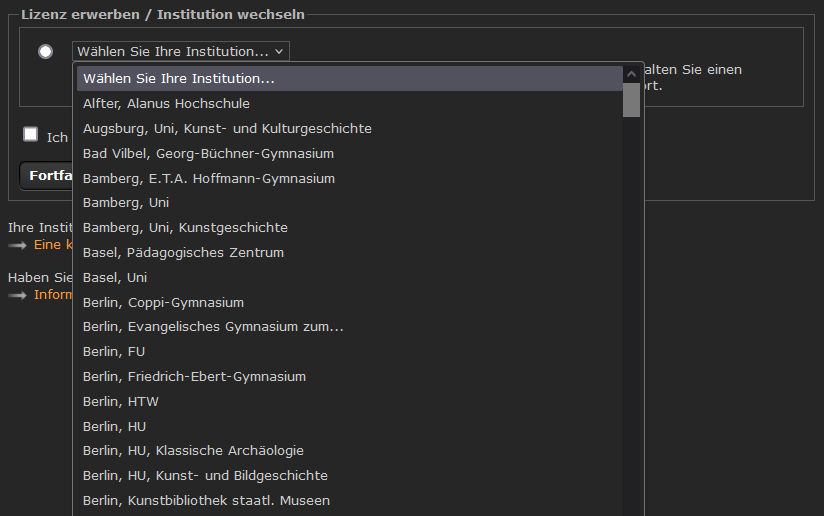
After your change, your content such as image collections, your own database, favorites, etc. will continue to be available to you. If your personal access has expired, it may still be possible to reactivate it with all your personal settings. Please ask us before you have to create a new account and repeat your work in the image archive. We will be happy to help.
Programming interfaces – APIs – facilitate the transfer of data between systems. They are used in programming to create software or interact with an external system. Via API, developers have access to standard commands for executing general operations so that code does not have to be rewritten. Also prometheus offers an API, which enables communication with pandora, the software from prometheus, for your own new applications. The following actions are available
(1) Submit search queries,
(2) retrieve images and
(3) retrieve image collections.
Detailed information can be found under Documentation
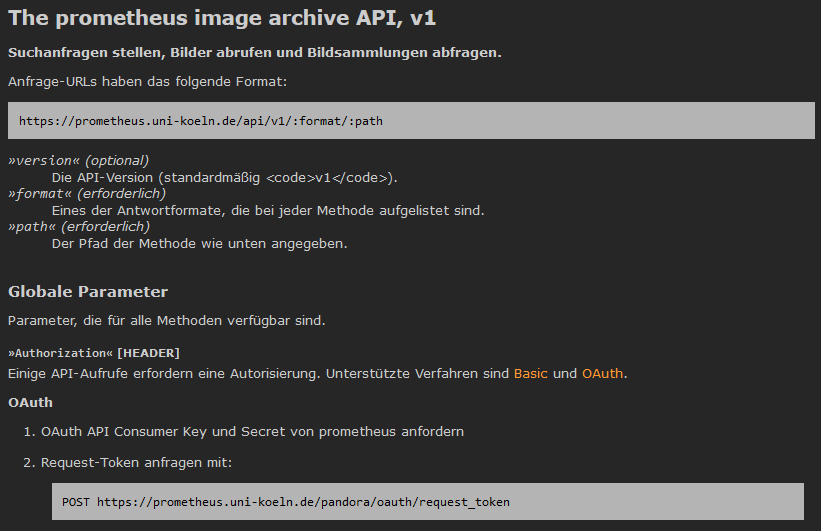
Various museums also offer interfaces that make it possible to integrate their online collections directly into prometheus, for example the Amsterdam Rijksmuseum. So far, we have integrated seven image databases via API: Amsterdam Museum, Getty Museum, Metropolitan Museum of Art, Paris Musees, Rijksmuseum Collection, Statens Museum for Kunst and The Cleveland Museum of Art.
The Art Institute of Chicago also offers its public data via a centralized, searchable API. To show what is possible with their interface, they also provide a script that can be used to query the API for public domain artworks, which are then displayed with letters, numbers and special characters, as ASCII-Art.








